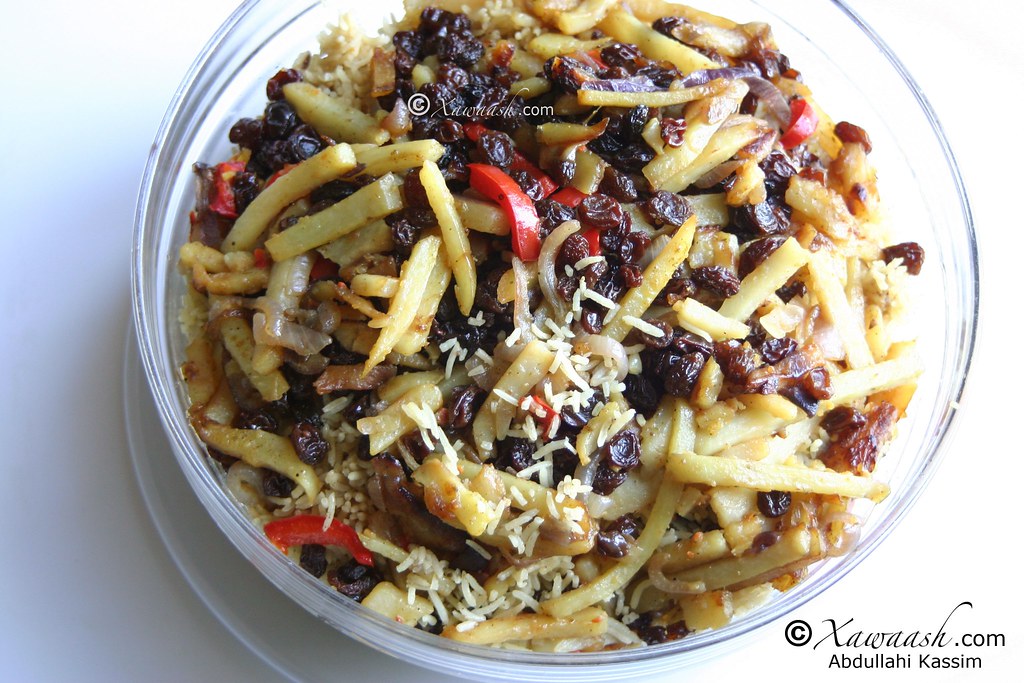Somali rice with toppings evokes old memories of family gatherings, and festive occasions. It reminds me particularly of ziyaras (rememberences) where large numbers of women gather to cook rice and meat in huge pots set on open fires.
I remember my grandparents’ house in Mogadishu, where a ziyara was held once a year to commemorate our great, great grandfather. He was said to have been a pious person who was generous to the poor. So on that day, the gates were open to everyone and the poor came there to be served by the family members. I remember everyone sitting on mats on the floor, strangers and the relatives, all eating from the same plate.
All the cooking was done in the huge yard that was half overtaken by bushes. The women, who were preparing the food, were divided into teams, and duties were assigned for peeling the onions and garlic, cutting the potatoes and peppers, cooking the meat, and preparing the stock for the rice. There was also a team that was in charge of the camel milk, a must have for ziyaras.
The yard was like a beehive with women scurrying around, cheerfully going about their assigned duties. In the midst of all of this, we played with other kids and caused mischief. Happy memories…
Le riz Somali et ses garnitures nous évoque de vieux souvenirs de rassemblements de famille, et d’occasions festives. Il me rappelle particulièrement les zirayas (commémorations) où un grand nombre de femmes se rassemblaient pour cuire du riz et de la viande dans de grandes marmites sur des feux en plein air.
Je me rappelle la maison de mes grands-parents à Mogadishu, où un ziyara se tenait chaque année en mémoire de notre arrière, arrière grand-père. Il était reconnu comme étant une personne très pieuse qui était généreuse envers les pauvres. Alors pour ce jour, les grilles étaient ouvertes à tous et les pauvres venaient pour être servis par les membres de la famille. Je me rappelle de tout le monde réuni assis sur des tapis par terre, inconnus et proches, tous mangeant dans le même plat.
Toute la cuisine était préparée dans le jardin qui était à moitié envahi par les buissons. Les femmes, qui préparaient la nourriture, étaient regroupées en équipes, et les tâches étaient assignées de peler les oignons et l’ail, couper les pommes de terre et les poivrons, cuire la viande, et préparer le bouillon pour le riz. Il y avait aussi une équipe qui était chargée du lait de chameau, indispensable pour les ziyaras.
Le jardin était comme une ruche de femmes s’affairant, qui accomplissaient leurs tâches joyeusement. Au milieu de tout ça, nous jouions avec les autres enfants et faisions des bêtises. De bons souvenirs…
Ingredients:
5 Tbsp Vegetable oil (drain after sauteeing)
2 Large onions (sliced)
3 Potatoes (cut into even strips)
1 Red pepper (sliced)
1 cup Raisins
½ Tbsp Vegetable seasoning salt
¼ tsp Xawaash (click on link)
Waxa loo baahan yahay:
5 QW Saliid caddeey
2 Basal waaweyn (jarjaran)
3 Bataato (baradho) (dhaadheer is-la’eg loo jaray)
1 Barbarooni gaduudan (jarjaran)
1 koob Sabiib
½ QW Maraq qudaar (Vegeta)
¼ qy Xawaash (halkaan guji)
Ingrédients:
3 Pommes de Terre (vous pouvez utiliser des frites surgelées)
2 Gros Oignons (Émincés)
1 Poivron Rouge (Émincé)
1 Mesure de Raisins Secs
½ cs de Condiment Légumes
¼ cc de Xawaash (cliquez sur le lien)
5 cs d’Huile Végétale (égoutter après la cuisson)
2 cs de Pignons de pin (optionnel)
Une pincée de colorant alimentaire jaune
Directions:
Cut the vegetables.
Qudaarta jarjar.
Instructions:
Couper les légumes.
Heat the oil using medium heat. Add the onions, cook for two minutes. Add the cut potatoes, cover and cook for 10 minutes. Add the red pepper and the Xawaash. Mix well; turn off the heat then add the raisins.
Bir dab dhexdhexaad saaran saliidda kushub. Basasha ku-dar, laba daqiiqo shiil. Bataatada ku-dar, dabool ee 10 daqiiqo kari. Barbarooniga iyo Xawaashka ku-dar. Si-fiican u-walaaq, kaddibna dabka ka-deji; sabiibka ku-dar.
Faire chauffer les épices dans l’huile. Ajouter le colorant jaune sur les pommes de terre égouttées. Verser les pommes de terre dans la poêle jusqu’à ce qu’elles soient à moitié cuites. Ajouter les oignons, puis deux minutes après ajouter le poivron rouge.
Une fois que les légumes sont tendres quand piqués à la fourchette, couper le feu et ajouter les raisins secs. Mélanger délicatement.
Place the mixture in a colander (with a plate underneath) to drain the oil.
Baasta miire ku-geddi, si ay saliidda uga miiranto.
Mettre le mélange dans une passoire (posée sur une assiette) pour égoutter l’huile.





I am newlywed and love your recipes as they help with the food i am unable to make! I am looking all over but I do not see the serving size for your recipes this info would help when i need to divide the ingredients to better suit my small family size
thanks again for your great recipes, its nice to see somali food being so well loved !!
Thank you for pointing this out. We will include the number of servings for the recipes, both the existing ones as well as future recipes.
asc aaaad ad u mahadsan tihin
Wacalaykum Assalaam Waraxmatullaahi Wabarakaatuhu,
Adigaa mahadda mudan walaal.
Asc wr wbr walaal adoo mahadsan bariiska sida loo kariyo oo video ah masoo gali kartiin insha Allah waa mahadsantihiin

Hadduu Ilaahey yiraahdo waan soo gelin doonnaa.
the website is very helpful, thank you…….
You are most welcome.
ASC Masha’Allah such a easy, step by step.. Never Loved cooking but after searching some useful blogs, I dont stop cooking, My family are getting a treat.. You save me Walahi.
Mahandsanid
Thank you for your great comment. Keep cooking and make your family happy.